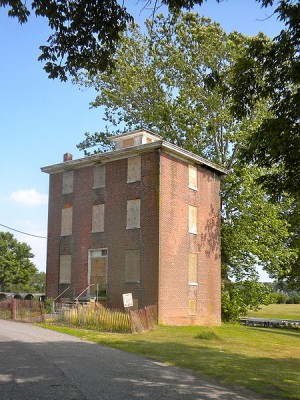
An Insane Asylum in New Jersey on the National Register of Historic Places
Yesterday was the final day of the 2009-10 school year in New York City, which means the city’s infamous “rubber rooms” also closed their doors. For good.
Those unfamiliar with the concept of “rubber rooms” can get up to speed here. The term itself is often said to refer to the padded walls of an insane asylum — or a solitary-confinement prison cell — and its first use is thought to go back a decade or so. But there’s evidence the term is much older. William Safire used it in 1983, in fact, saying it was “bureaucratese for an office without work to do.” That’s exactly what the rubber rooms in New York City were — places where people were paid not to work.
A short piece in yesterday’s New York Times served to remind readers of the insanity that is the rubber room. Teachers are escorted to the room by a security guard. The lunchroom down the hall cannot be used for lunch. Dishes must be done in the bathroom sink. And then fights break out. That’s my chair! … Stop playing the guitar! … Don’t throw your garbage at me!
Sounds like a short story by Franz Kafka.
Except it’s real, unlike Kafka’s Gregor Samsa — who awakes one day to find himself transformed into a giant insect.
My favorite part about the rubber room saga is the clear and compelling role that journalism played in shutting down New York City’s rubber rooms. Interestingly, both city officials and union leaders have been calling for an end to the rubber rooms for years. And, believe it or not, newspapers have been covering rubber rooms for years. The New York Times first reported on rubber rooms in 2004.
But it wasn’t until Steven Brill’s scathing piece in the New Yorker last August that everyone seems to have started paying attention. As the article made the rounds, shutting down the rubber rooms became a priority for Mayor Michael Bloomberg, Schools Chancellor Joel Klein and UFT President Michael Mulgrew.
Outrage went mainstream. That the rubber rooms were said to cost the city $30-60 million a year fueled the fire, not least because of massive budget cuts necessitated by the recession. Taxpayers demanded to know how, in this era of tight budgets, the city could justify throwing away millions of dollars on people who were paid to do nothing.
A documentary called The Rubber Room, five years in the making, began grabbing headlines. A trailer was released. Excerpts of the documentary were included in Davis Guggenheim’s Waiting for “Superman,” which premiered at the Sundance Film Festival in January and took home the audience award for best U.S. documentary.
And then the announcement on tax day, April 15th, that the rubber rooms would be shuttered. All sides rushed to declare victory.
Bloomberg conceded that media coverage had influenced the decision. “Given the amount of press this subject has gotten, to say that this is a big deal is probably an understatement.” If you watch the video of the press conference, you’ll see wry smiles on both Bloomberg and Klein’s faces as the mayor says these words.
A clearer case of journalism influencing politics would be hard to find.
Rubber rooms are now dead in New York City, but they appear to be alive and well elsewhere. Read about the situation in Los Angeles here and here. In what other cities are rubber rooms thriving? Please let us know in the “Comments” section below!



